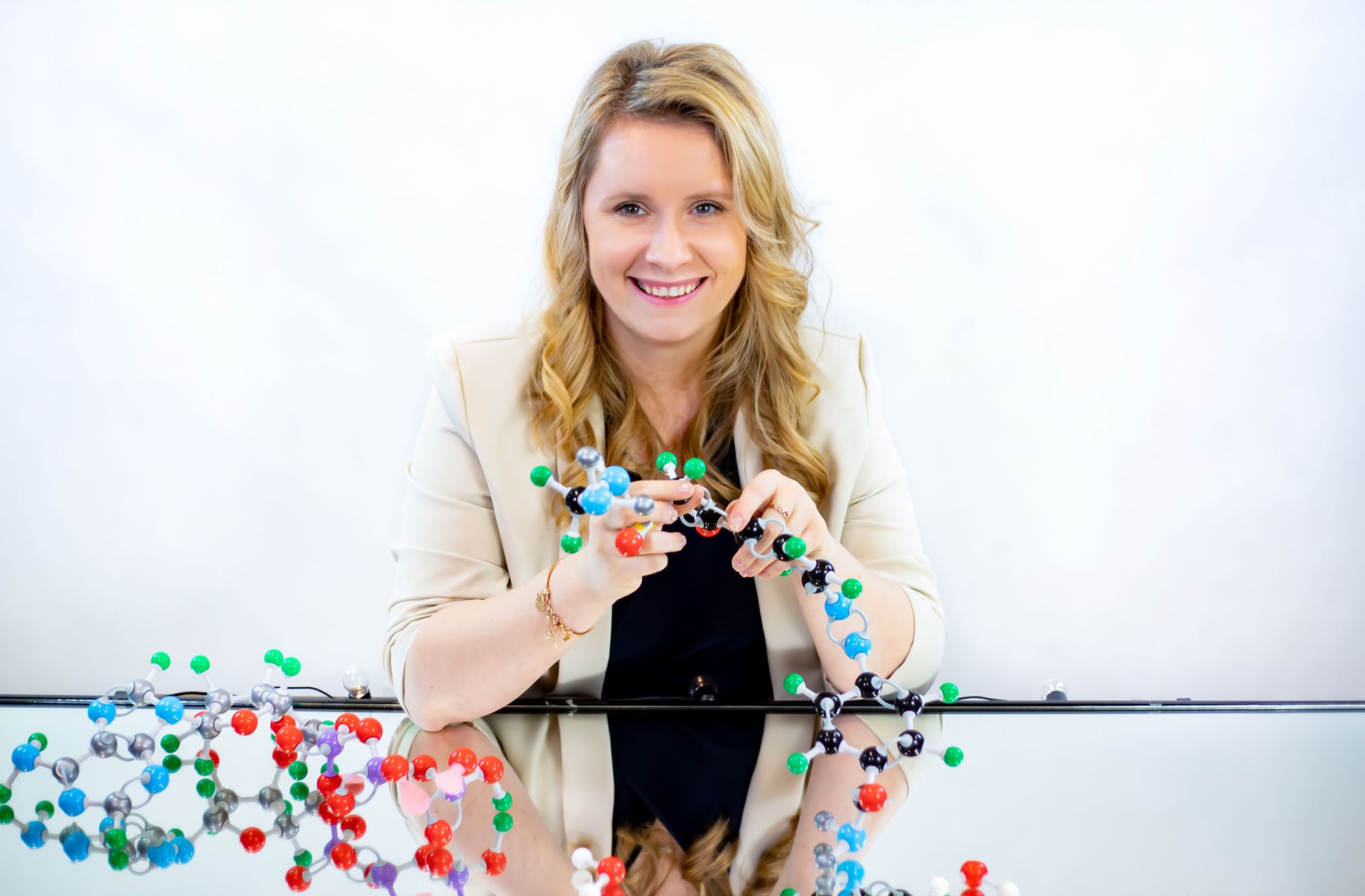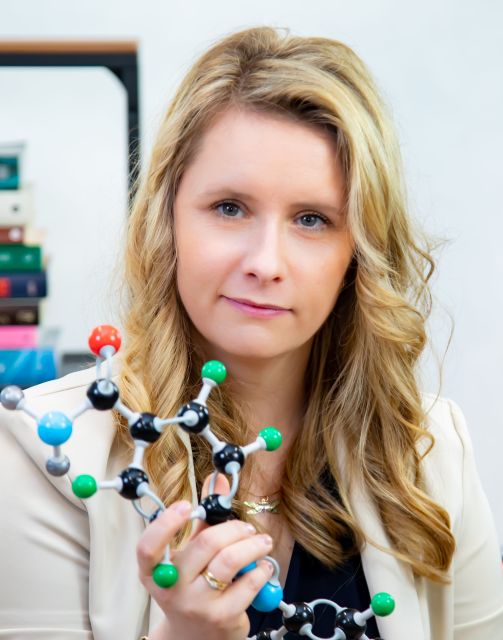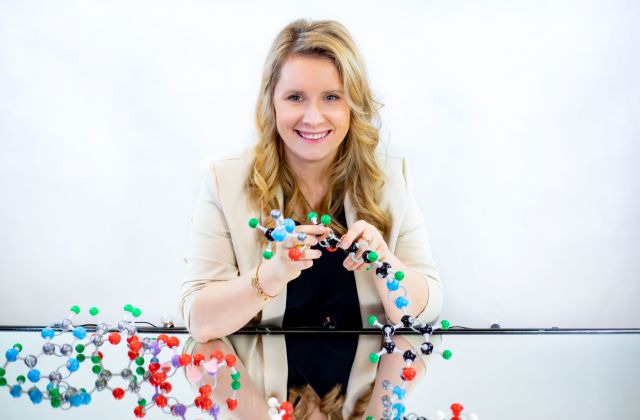Principal Investigator
:
dr hab. Karolina Mikulska-Rumińska
Nicolaus Copernicus University in Toruń
Panel: ST4
Funding scheme
: SONATA BIS 12
announced on
15 June 2022
The human body is a complex system composed of quadrillion cells. Healthy cells live and die, and their lifetime is precisely regulated and controlled via so-called regulated cell death mechanisms. These highly specialised processes play a key role in maintaining stable conditions within the body, allowing it to eliminate cells that are no longer useful or may become dangerous. However, sometimes they are disrupted, and cells begin to divide in an uncontrolled way, leading to oncogenesis.
 Developing a spatial model of a potential drug via computer simulations, photo by Studio AiR Bros, Toruń
In 2012, the scientific community was moved by the proposed concept of a new mechanism of regulated cell death, characterised by the formation and accumulation of so-called lipid peroxides, which cause extensive membrane damage and dysfunction of other proteins. The process was called ferroptosis. It is normally used to eliminate useless or potentially dangerous cells but has also been identified as a cell death mechanism involved in Parkinson’s and Alzheimer’s disease and sepsis, as well as a factor contributing to tissue degradation in brain trauma, kidney disorders, and asthma. The initiation of ferroptosis could also find promising applications in the therapy of treatment-resistant cancers.
Developing a spatial model of a potential drug via computer simulations, photo by Studio AiR Bros, Toruń
In 2012, the scientific community was moved by the proposed concept of a new mechanism of regulated cell death, characterised by the formation and accumulation of so-called lipid peroxides, which cause extensive membrane damage and dysfunction of other proteins. The process was called ferroptosis. It is normally used to eliminate useless or potentially dangerous cells but has also been identified as a cell death mechanism involved in Parkinson’s and Alzheimer’s disease and sepsis, as well as a factor contributing to tissue degradation in brain trauma, kidney disorders, and asthma. The initiation of ferroptosis could also find promising applications in the therapy of treatment-resistant cancers.
Interestingly, research implies that ferroptosis can be induced and used by P. aeruginosa in the pathology of pneumonia and cystic fibrosis. This bacterium is considered by the World Health Organization as a pathogen with high medical importance because its infecting abilities and multidrug resistance result in long-term chronic airway infections in patients with cystic fibrosis. These people suffer since currently, there are only possibilities to minimise the symptoms of infections, but there is no effective long-term prevention for their condition. The goal of the project is to address this problem and solve the riddles behind P. aeruginosa-induced ferroptosis in humans in order to improve the quality of life for people with cystic fibrosis and other disorders associated with this bacterium.
 Dr hab. Karolina Mikulska-Rumińska, photo by Studio AiR Bros, Toruń
The project uses computational methods such as molecular dynamics and molecular docking simulations, together with bioinformatics and programming abilities, to uncover the mechanisms that are used by P. aeruginosa to initiate ferroptosis in human cells and ultimately deliver new chemical compounds that could serve as a basis for potential drugs to treat pneumonia and cystic fibrosis. We are also planning to develop a new computational tool that will be available for other scientists as part of the program called ProDy (a Python package), in use since 2011. Our modelling results, including potential inhibitors, will be tested in biochemical experiments by our project collaborators.
Dr hab. Karolina Mikulska-Rumińska, photo by Studio AiR Bros, Toruń
The project uses computational methods such as molecular dynamics and molecular docking simulations, together with bioinformatics and programming abilities, to uncover the mechanisms that are used by P. aeruginosa to initiate ferroptosis in human cells and ultimately deliver new chemical compounds that could serve as a basis for potential drugs to treat pneumonia and cystic fibrosis. We are also planning to develop a new computational tool that will be available for other scientists as part of the program called ProDy (a Python package), in use since 2011. Our modelling results, including potential inhibitors, will be tested in biochemical experiments by our project collaborators.
Based on state-of-the-art biomolecular modelling methods, the project will bring us closer to an in-depth understanding of ferroptosis in the hope of developing new intervention methods for long-term infections in patients with cystic fibrosis and other P. aeruginosa-induced diseases.
Project title: Computational deciphering of pro-ferroptotic cell death protein machinery as a fundamental step in the search for therapeutic targets in pneumonia and cystic fibrosis
dr hab. Karolina Mikulska-Rumińska
Graduate in medical physics from the Nicolaus Copernicus University in Toruń, Mikulska-Rumińska holds a PhD in biophysics and a habilitation degree (DSc) in physical sciences. She uses computational biophysics tools to study the molecular basis of biological systems of particular importance to medicine and industry. She has completed research fellowships at EPFL (Switzerland), University of Pittsburgh (USA), Stony Brook University (USA) and ADAMED. She has participated in more than 15 grants, serving as a PI in 9. She is also a winner of the L'Oréal-UNESCO International Rising Talents Award, the Stefan Pieńkowski Research Award of Division III of the Polish Academy of Sciences, the L’Oréal-UNESCO For Women in Science programme, the international Sciex-NMSch scholarship, the scholarship of the Minister of Science and Higher Education and the Marshal’s scholarship. She was included in the “Forbes Women” list of the top 100 most inspiring Polish women in 2021.


